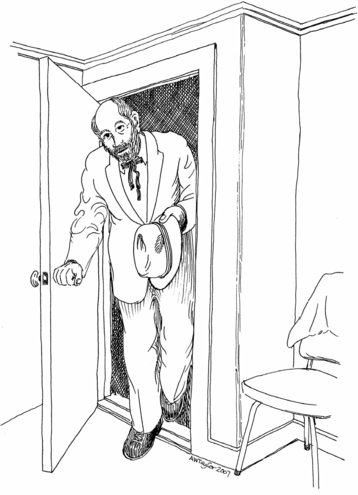The Golden Leg (7 page)
Authors: Dale Jarvis


J
ake was a strong young man, and well
enough liked by everyone. There was a great spirit of fun in him, and he was
always ready for a prank. But at the same time, and in spite of his love for a
joke, he was a trustworthy sort of fellow.
Jake got a job with a merchant, and served him well. Every time the merchant
needed to send someone to pick up supplies, or if he needed an important message
delivered, he would send Jake. It was on one of these errands that Jake had the
good fortune to meet young Elizabeth.
Elizabeth was a fair young maid, and Jake fell head over heels in love with
her. Elizabeth herself was mighty impressed with Jake, and they started to spend
all their available time together. Before too long, word spread that Jake had
asked fair Elizabeth to marry him.
It was in the month of November that Elizabeth decided one evening to visit
Jake at his house. It was around the time of the full moon, so there was plenty
of light to guide Elizabeth's way.
To get to Jake's house, Elizabeth had to follow the path as
it
led through a marshy piece of ground. It was cold that November, and the ground
had frozen solid. There were no trees and only low bushes around her. There was
not a soul to be seen.
Elizabeth hummed a tune to herself and hurried on her happy way. In front of
her along the path, who should come striding along but Jake himself, a smile on
his face and his gun slung over his shoulder.
“Hello Jake!” cried the girl. “Wait for me, won't you?”
Jake did not stop. He moved a little farther along the path, and Elizabeth
noticed that he moved with a strange gliding motion, rather than his usual
jaunty walk. Then, before the astonished girl's eyes, he vanished
completely.
Elizabeth looked around, but there was nowhere he could have hidden in the
frozen marsh. The girl felt faint. She gathered herself together and hurried as
quickly as she could the rest of the way to Jake's house. Expecting the worst,
she burst in.
There sat Jake, as calm as anything. He was seated, in his stocking feet, at a
little table fixing a pair of boots. He had not been outside that night, and
Elizabeth knew immediately that she had seen something unnatural. It was not one
of Jake's usual pranks.
Weeks passed, and one winter's day Jake's boss sent him out on one of his
regular trips to buy supplies. Jake set off, a smile on his face, and his gun
slung over his shoulder. But Jake did not return. When he had been gone for some
time, the men in the town got together and sent out a search party.
Only a short distance from the town, the search party found
Jake. He had stumbled on the ice, and as he fell the gun had gone off. The shot
had ripped through his body, his blood staining the white snow red. The men
carried him back, and Elizabeth flew to his side, but it was too late to help
Jake. That night he died.
From that day to this, people have said that the figure Elizabeth met on the
marshy path that November night had been a token, or a sign, of Jake's coming
death. But that knowledge brought little consolation to Elizabeth, who mourned
the loss of her own true love to the end of her days.

A
mong the great unknown’s many strange
ghost stories, there is a great tradition of what are known as “anniversary
hauntings.” An anniversary haunting is exactly what its name might suggest; it
is a type of haunting that occurs during the anniversary of some important
event.
The event itself could be a birthday, a specific holiday, or the anniversary of
some great historical occasion. Quite often it is a haunting that occurs
annually at the time of the ghost’s death.
One evening many years ago, when a moonless night was twice as black as the
bottom of a coal bin, a man was walking home. As he walked along the path, he
heard the footsteps of someone else walking along with him.
He looked ahead but could see nothing in the darkness, and so he drew his coat
closer around himself and kept walking.
Eventually the path curved a bit, and then crossed over a little footbridge.
When he reached the bridge, he could see standing in the middle the figure of a
woman, wearing a long grey dress.
The woman was not known to him, which was odd for such a small
community. She stood in the centre of the bridge, blocking his way, and was
weeping loudly. Great sobs wracked her body, and tears flowed freely down her
cheeks.
Surprised by this sight, the man asked the crying lady what was wrong. She did
not answer, and made no move to shift out of his way. She simply stood there
weeping, one hand on the railing of the bridge, blocking his path.
When the woman did not answer, he reached out his hand to touch hers where it
rested on the railing of the bridge. Her fingers were icy cold. Only at the
touch did she move, turning away from the man, and drawing her body close to the
railing, giving him just enough room to pass by.
The man stepped carefully around her, and she continued with her lamentations
as he passed her by. He tried to speak to her again, and when she did not answer
a second time, he continued his homeward journey, troubled by the woman’s
obvious distress.
When he reached the warmth of his own kitchen, he told his wife and his
mother-in-law what he had seen, and how he did not recognize the woman as being
from the community.
The older woman, the man’s mother-in-law, seemed unfazed by the story of the
man’s strange experience. In turn, she revealed to the man that what he had seen
was no earthly woman, but instead the phantom of a woman who had died many years
before.
According to the old woman, the ghostly figure on the bridge was the spirit of
a local woman who had died during
childbirth. Every year after
her untimely parting, she would appear on the anniversary of her death somewhere
in the community. She would be seen weeping and wailing, bemoaning her own
demise and her separation from the child she had lost.

O
nce, long ago, in a time when water was
not quite as wet as it is today, there lived a fisherman and his wife. They were
not a wealthy couple, but in their hearts they were good people, and they were
very hard workers, which is what mattered in those days.
In the fall of the year when the fishing was done, the fisherman and his wife
got in their small boat and sailed across the bay. There, on the far side of the
bay, the wife picked berries while the man went out into the woods to cut timber
for making a new home. He cut the logs, trimmed them, hauled them back to the
shore, and together he and his wife built a tiny house.
One evening when the house was finished and a fire was burning merrily in the
stove, the man decided he would go visiting the neighbours who lived just down
the shore. He put on his cap, kissed his wife goodbye, and headed off into the
night.
The woman sat down to do some sewing. She made herself comfortable in the old
rocking chair by the woodstove
and began to work. She rocked and
she sewed, and she sewed and she rocked.
As she sewed, the door to the tiny house swung open and a stranger walked in.
He was a tall man, so tall that he had to duck his head to get in through the
door. He was dressed in a black suit with a black tie knotted neatly around his
neck, and he carried an old black hat in his hands.
The woman was startled, like you would be if a stranger walked into your house,
but she put down her sewing and remembered her manners.
“Well hello,” she said, and she offered him a cup of tea, which was the only
proper thing to do.
The stranger said absolutely nothing. He looked about the room, then turned his
body around and stepped back out the door, still holding his hat in his hands.
He closed the door behind him, and that was the end of that visit.
When her husband returned home, the wife told him about the man dressed all in
black
“It seems as if he left as soon as he saw I was alone,” she said.
The next night, when the fire was burning merrily in the stove, the husband
said he was off to visit the neighbours once more. He put on his cap, kissed his
wife goodbye, and headed off into the night.
The woman sat down to do some sewing. She made herself comfortable in the old
rocking chair by the woodstove and began to work. She rocked and she sewed, and
she sewed and she rocked.
And as she sewed, the door to the tiny house swung open and the
stranger walked in, ducking his head to get in through the door. He was wearing
the same black suit with a black tie knotted neatly around his neck, and he
carried his old black hat in his hands.

This time the woman was not quite as startled as she had been
the night before. She put down her sewing and spoke to the stranger.
“Hello,” she said, and again she asked him if he would like a cup of
tea.
The stranger said nothing. He looked about the room. Then he turned his body
around and stepped back out the door, still holding his hat in his hands. He
closed the door behind him, and that was the end of that visit.
When her husband returned home, the wife told him about the man dressed all in
black.
“He left as soon as he saw I was alone,” she said, “and tomorrow night you
better be here, because if he comes again, you should stop him and see what he
wants.”
The next night, the husband did not go visiting the neighbours. He sat on the
daybed by the stove and waited while his wife made herself comfortable in the
old rocking chair and began to sew. She rocked and she sewed, and she sewed and
she rocked.
As she sewed, the door to the tiny house swung open and the stranger walked in,
ducking his head to get in through the door. He was wearing the same black suit
with the same black tie knotted neatly around his neck, and he carried his old
black hat in his hands. He came right into the house and stood in the centre of
the floor.
“Well, my good man,” said the husband, “what do you want from us?”
“Sir, “spoke the stranger, in a deep, hollow sort of voice,
“I
beg of you to move your door somewhere else. If you do me this favour, I will
never bother you again.”
The husband said he would do just that. At this, the stranger nodded. He then
turned around and stepped back out the door, still holding his hat in one hand.
He closed the door behind him.
That was the last of his visits, for the very next morning the husband went to
move the door. As he looked around, he discovered an old grave, right where he
had built the door to his tiny house. Every time anyone went in or out the door,
they were walking over the grave of the man with the hat.
Needless to say, the man lost no time in boarding up the opening of the old
doorway. He moved the door around to the other side of the house, and they never
saw the stranger again.